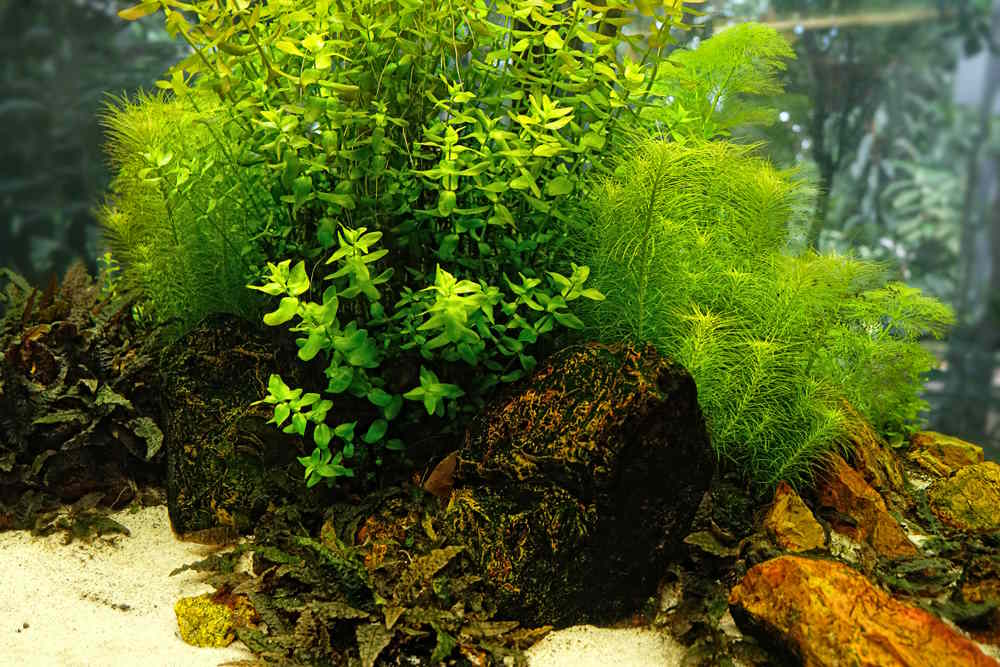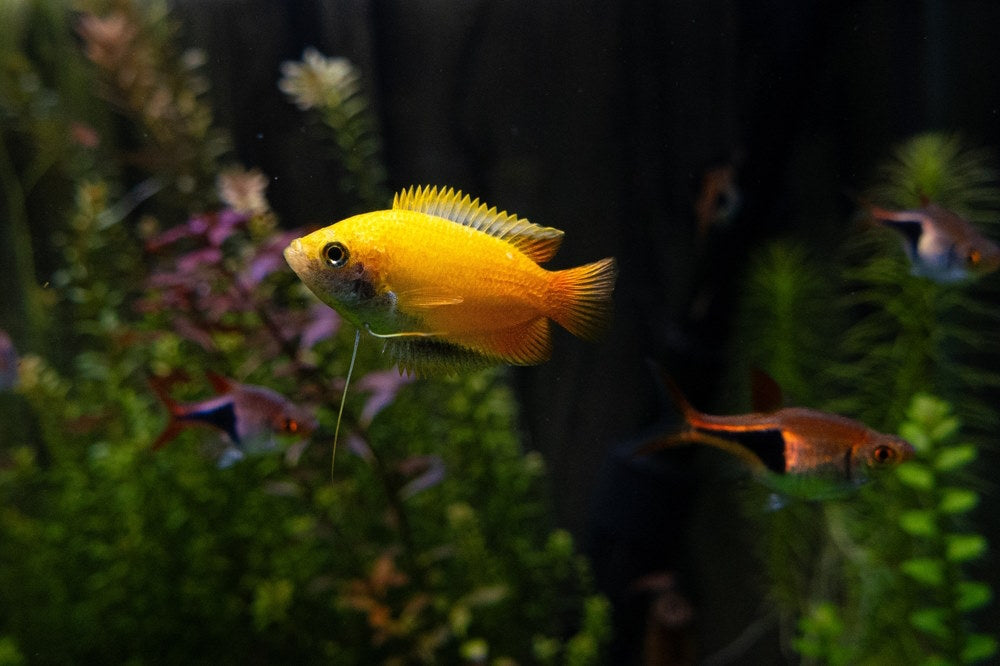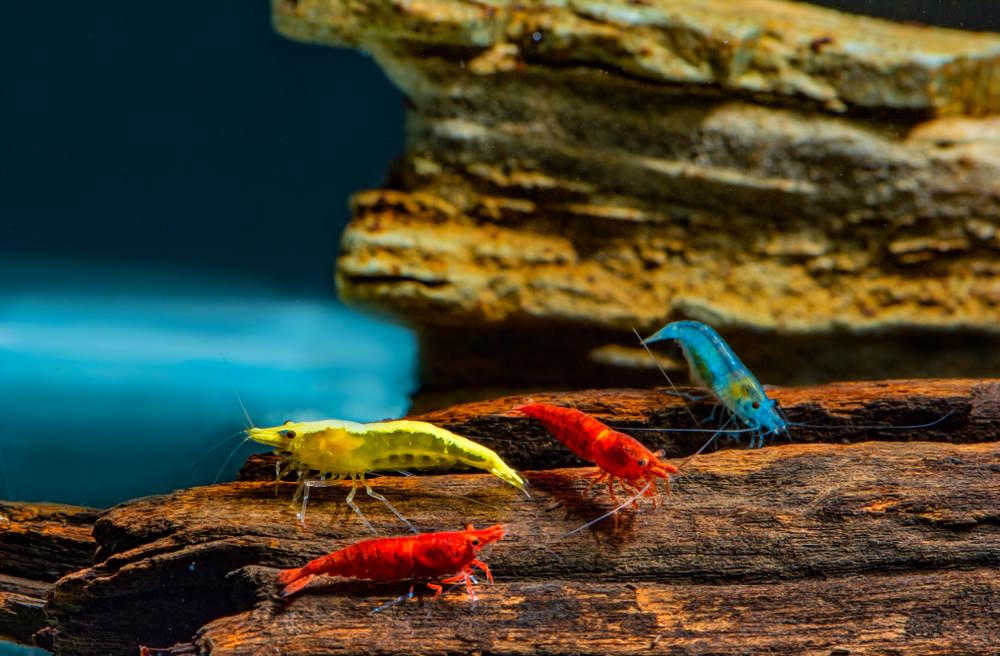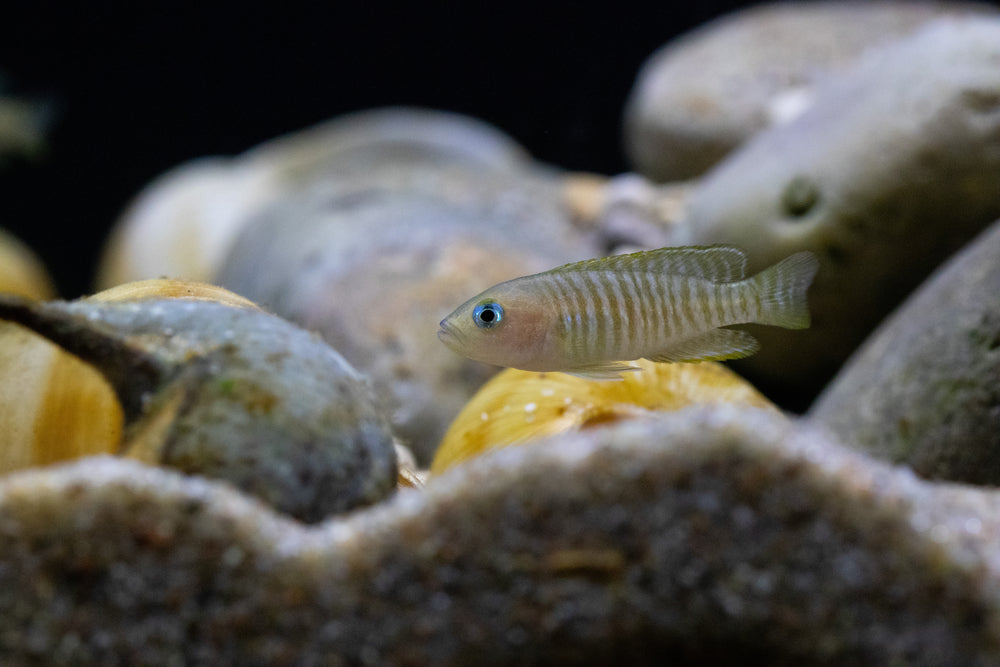5 Best Fish Tank Ideas for Small Aquariums
Small fish tanks between 5–20 gallons are some of the most popular sizes in the freshwater aquarium hobby because of their reduced footprint and cheaper cost. Even with the size limitation, there are countless possibilities when it comes to choosing the species, layout, and purpose of the fish tank. To help get your creative juices flowing, here are 5 stocking ideas that might be perfect for your next nano fish tank.
1. Nano Aquascape

Simple aquascape with center island of plants surrounded by rocks
If you’ve never tried your hand at aquascaping or making a beautifully designed planted tank, a small aquarium can be the perfect size to get started with. The idea is to use a combination of hardscape, live plants, and animals to create a memorizing underwater garden. If you have no idea what to make, you can look online for examples of aquascapes to emulate, sketch out a design, and then write a list of materials you’ll need. Lay out the rock and/or driftwood inside your empty tank to build up the “bones” of the scape. Many aquascapers recommend using all the same type of wood and rock for a more cohesive look.
The next step is to plant the foliage. In general, we like to put the small plants in the front and the tall plants in the back so that all of the vegetation can be easily seen. Finally, it’s time to pick the fish. Since the plants and hardscape are the main focus of the aquarium, let’s choose nano species that won’t visually overwhelm the aquascape. Celestial pearl danios are a popular choice for aquascapes because of their red-orange fins and golden pearls on their bodies that make them look like miniature brook trout. Another schooling fish to consider is the tiny chili rasbora, whose spicy red colors will complement the greenery of the plants. The lower layers of the aquarium can be occupied by nano bottom dwellers like rosy loaches or habrosus corydoras. Then to help keep the aquascape clean of algae, use a group of amano shrimp, otocinclus catfish, or nerite snails. Any combination of these peaceful species will bring a lot of interesting activity to your planted aquarium.
2. Centerpiece Tank

Honey gourami as the centerpiece with a school of harlequin rasboras
Unlike the nano aquascape, the focal point of this type of aquarium is one single fish. We want this centerpiece creature to be visually striking and slightly bigger that the rest of the rest of the tank mates. Some hobbyists will even choose to keep a single “wet pet” with no other inhabitants in the fish tank. Of course, since the tank only holds 5–20 gallons of water, look for a species that reaches a maximum of 3 inches (8 cm) in length. Also, the decorations and live plants should not be overly crowded, or else the main attraction may be hard to see and not have enough room to swim around.
Many beginners start with a betta fish as their first centerpiece fish because of their hardiness and wide range of colors. Given its semi-aggressive nature, you can keep it alone in a 5-gallon or larger aquarium that contains a gentle sponge filter and heater to warm the water. If the betta fish is more relaxed and able to handle tank mates, it would be best to increase the tank size to at least 20 gallons, add taller plants to block line of sight, and find some peaceful schooling fish that will keep out of the betta’s way. For more details, see our betta care guide.
Smaller gouramis are also an excellent choice as centerpiece fish for nano aquariums. Their blimp-like bodies, bold personalities, and beautiful colors all help them stand out from the crowd. The dwarf gourami is semi-aggressive like the betta fish, but we’ve found that female powder blue dwarf gouramis are calmer and can be kept in a 20-gallon community setup. Honey gouramis and sparkling gouramis are also fairly chill and will get along well with smaller schooling fish like tetras, danios, and cory catfish.
3. Shrimp Tank

A “Skittles” tank with Neocaridina shrimp of many colors
One type of animal that isn't safe with betta fish or gouramis are dwarf shrimp. In fact, most fish treat adult and baby shrimp as delicious snacks. Therefore, the safest course of action is to use a 10- or 20-gallon tank as a species-only setup for breeding shrimp. If you aren’t interested in breeding, then here are some tank mates that would be safe with adult shrimp. People fall in love with them because of their constant movement, the way they swarm around food, and of course their gorgeous colors.
If you are new to keeping shrimp, start with Neocaridina shrimp (or cherry shrimp). They are easier to care for than Caridina shrimp (e.g., Taiwan bee and crystal shrimp) because they can handle a wider range of water parameters, but they do prefer slightly higher pH and GH so they get enough minerals to produce healthy exoskeletons. They can even live in a fish tank kept at room temperature without an aquarium heater. To give them the best chance for success, prepare a mature, seasoned aquarium of 10–20 gallons that has lots of microfauna and algae for them to graze on. Newly set-up tanks are usually quite sterile and don’t have the ability to sustain life yet, so you want to have healthy, growing plants, mulm on the substrate, and even signs of algae before you add any shrimp. For more information on these adorable, little critters, read the full article.
4. Shell Dweller Tank

Neolamprologus multifasciatus shell dweller
If you’ve never played with African cichlids before, you’re in for a treat. Both Neolamprologus multifasciatus and N. similis are small enough to live in a 20-gallon long, species-only tank. These shell dwellers are incredibly entertaining to watch because of their unique breeding behaviors. Fill the aquarium with at least 2 inches of aragonite sand, and add some tall rocks to block line of sight and minimize bickering among the males. You’ll also need to provide at least 3–4 extra-large escargot shells per adult fish. The dwarf cichlids use the snail shells to hide from predators, spawn, and raise their fry. As busy, little builders, they love to dig in the sand and move their shells around to the “best” location, so be prepared to see some major construction in the tank. Feed them plenty of crushed flakes, nano pellets, baby brine shrimp, and frozen bloodworms, and soon you will start to see a cloud of tiny fry lingering around the openings of the snail shells. Learn more about the amazing shell dweller in this care guide.
5. Breeding Pair Setup

A pair of Apistogramma dwarf cichlids swimming together
While both cherry shrimp and shell dwellers are relatively easy to breed, some hobbyists want to try a slightly harder challenge. The Apistogramma genus includes almost 100 species of South American dwarf cichlids that come in all sorts of jaw-dropping colors and patterns. A pair of “apistos” can be bred in a 15- to 20-gallon aquarium if you create the right environment. We suggest starting with A. cacatuoides or A. agassizii since they are readily available and beginner friendly.
Make sure you have at least one male and one female. When apistos are young, they may be hard to sex, so your best bet is to buy a group of them, let them naturally pair off, and then rehome the rest. If the apistos are older, you can tell the males by their larger size, longer fins, and brighter hues. Since they are cave spawners, set up the breeding tank with at least 1 inch of substrate and an apisto cave in each of the back corners. Adding some java moss and other plants in the front will help the pair to feel more comfortable. Keep the water quality high and the meal portions big, and soon you may see the parents guarding the eggs and escorting the babies to the best feeding spots. For more information, see our apistogramma care guide.
There are many, many more options when it comes to nano fish, so don’t forget to check out our list of preferred online retailers to see what they have in stock and how soon they can deliver them. For more inspiration, read about our top 10 stunning nano fish for your next small aquarium.




